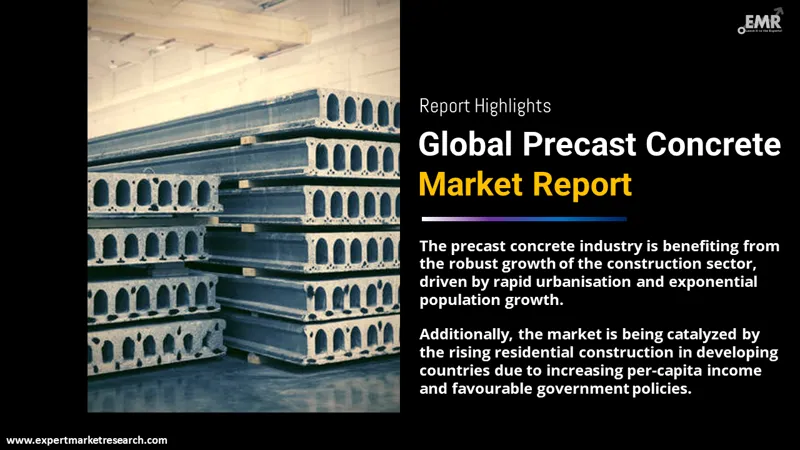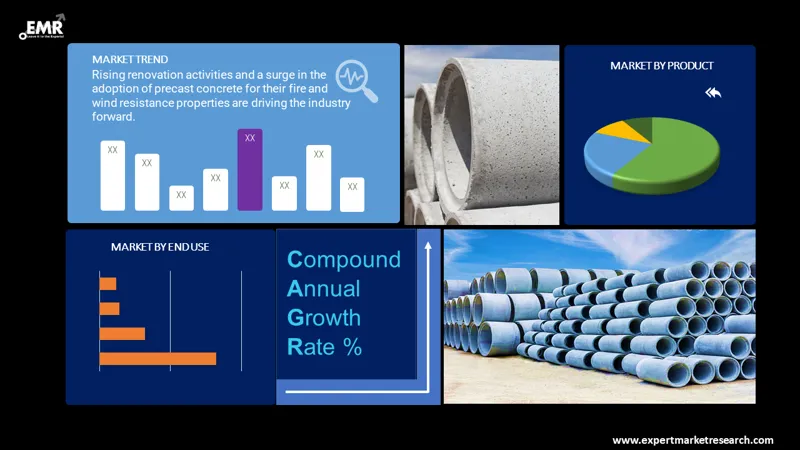
Consumer Insights
Uncover trends and behaviors shaping consumer choices today
Procurement Insights
Optimize your sourcing strategy with key market data
Industry Stats
Stay ahead with the latest trends and market analysis.
The global precast concrete market attained a value of nearly USD 121.25 Billion in 2025. The market is further expected to grow at a CAGR of 5.00% during the forecast period of 2026-2035 to reach a value of USD 197.50 Billion by 2035.
Base Year
Historical Period
Forecast Period
Compound Annual Growth Rate
5%
Value in USD Billion
2026-2035
*this image is indicative*
| Global Precast Concrete Market Report Summary | Description | Value |
| Base Year | USD Billion | 2025 |
| Historical Period | USD Billion | 2019-2025 |
| Forecast Period | USD Billion | 2026-2035 |
| Market Size 2025 | USD Billion | 121.25 |
| Market Size 2035 | USD Billion | 197.50 |
| CAGR 2019-2025 | Percentage | XX% |
| CAGR 2026-2035 | Percentage | 5.00% |
| CAGR 2026-2035 - Market by Region | Asia Pacific | 5.7% |
| CAGR 2026-2035 - Market by Country | India | 5.8% |
| CAGR 2026-2035 - Market by Country | China | 5.5% |
| CAGR 2026-2035 - Market by Product | Transportation Products | 5.9% |
| CAGR 2026-2035 - Market by End Use | Infrastructure | 6.0% |
| Market Share by Country 2025 | Germany | 4.4% |
The precast concrete market is gaining substantial market share globally, driven by its cost-effectiveness, durability, and sustainability. With increasing construction projects in urban areas, the demand for precast concrete components like panels, beams, and slabs is rising. Moreover, the focus on green building materials and energy-efficient construction solutions is bolstering the market. Precast concrete offers reduced construction time and enhanced structural integrity, making it a preferred choice across residential, commercial, and infrastructure projects. Additionally, technological advancements in precast manufacturing and innovations in design flexibility are fueling growth. Leading regions such as North America, Europe, and Asia-Pacific are witnessing robust adoption due to rising infrastructure investments. As industries emphasize eco-friendly practices, precast concrete aligns perfectly with sustainable construction goals, driving its market prominence.

Read more about this report - REQUEST FREE SAMPLE COPY IN PDF
The robust growth of the construction sector owing to the rapid urbanisation and exponential population spurge is aiding the precast concrete industry. Moreover, the rising residential construction in the developing countries due to increasing per-capita income and favourable government policies is catalysing the market growth. As the demand for affordable housing increases, precast concrete is increasingly used to produce a large number of identical components, therefore lubricating the market growth. Precast concretes also offer high flexibility and precision, which aids in the creation of aesthetically pleasing and diverse production, which is consequently fuelling the market growth. It also reduces the construction time and skilled labour cost; hence, they are increasingly used in affordable construction, which is further accelerating the industry growth.
As precast concrete is made in a controlled environment, it is easier to control and monitor its quality, which is increasing its demand in the infrastructure sector and further catalysing the market growth. It also eliminates the demand for favourable weather conditions in the construction industry, therefore providing further impetus to the industry growth. Additionally, it reduces noise and dust pollution, and the use of technology in the production of precast concrete allows optimal utilisation of materials, such as cement, water, and construction steel; hence produces minimum waste output while providing an eco-friendly alternative, which is further augmenting the market growth.

Read more about this report - REQUEST FREE SAMPLE COPY IN PDF
Precast concrete refers to concrete that is prepared, cast, and cured, usually in a controlled factory environment using reusable moulds. It can be joined to other elements to form a complete structure and is typically used for wall panels, columns, beams, staircases, and tunnels, among others.
The major products of precast concrete are:
Based on the end use, the market is segmented into:
The EMR report looks into the regional markets of precast concrete like:
| CAGR 2026-2035 - Market by | Country |
| India | 5.8% |
| China | 5.5% |
| Saudi Arabia | 5.4% |
| Mexico | 5.3% |
| UK | 4.8% |
| USA | 4.7% |
| Canada | XX% |
| Germany | XX% |
| Italy | XX% |
| Japan | XX% |
| Australia | XX% |
| Brazil | XX% |
| France | 4.3% |
Increasing renovation activities by the government in emerging economies, such as India and Brazil, are increasing the demand for precast concrete, further aiding the market growth. Moreover, renovations in the hospitality industry are also driving the market growth. An increase in public and private investments due to rapid industrialisation is also propelling the market growth. Precast concrete offers fire resistance and provides high protection environmental influences; hence, they are used in the construction of power stations with high safety hazards and highways, which are further propelling the market growth.
Precast concrete can resist high pressure forces and increase the tensile strength, which results in optimum protection against high loads. Moreover, with the advancement of technology, microchips are embedded in precast concrete to gather information about loads and forces and send out a signal to warn the inhabitants during seismic risk, consequently decreasing the risk for a collapse of the building during an earthquake; such developments are further invigorating the market growth. Low thermal conductivity and mass reactance of precast concrete cause a balance between the extreme temperature changes and slows down the cooling or heating of the space. Moreover, the use of intelligent precast concrete materials can isolate, heat or cool while producing extra energy. The use of precast concrete also reduces the cooling costs, which are expected to aid the market growth.
The report presents a detailed analysis of the following key players in the global precast concrete market, looking into their capacity, market shares, and latest developments like capacity expansions, plant turnarounds, and mergers and acquisitions:
The comprehensive report looks into the macro and micro aspects of the industry. The EMR report gives an in-depth insight into the market by providing a SWOT analysis as well as an analysis of Porter’s Five Forces model.




*While we strive to always give you current and accurate information, the numbers depicted on the website are indicative and may differ from the actual numbers in the main report. At Expert Market Research, we aim to bring you the latest insights and trends in the market. Using our analyses and forecasts, stakeholders can understand the market dynamics, navigate challenges, and capitalize on opportunities to make data-driven strategic decisions.*
Get in touch with us for a customized solution tailored to your unique requirements and save upto 35%!
In 2025, the global precast concrete market attained a value of nearly USD 121.25 Billion.
The market is projected to grow at a CAGR of 5.00% between 2026 and 2035.
The market is being driven by the growth of construction and infrastructure industries, increasing per-capita income, and the favourable policies of various governments.
The key trends of the market include the increasing renovation activities and the growing use of precast concretes for fire and wind resistance.
The major regions in the market are North America, Latin America, the Middle East and Africa, Europe, and the Asia Pacific.
The major products of precast concrete in the market are structural building components, architectural building components, transportation products, and water and waste handling products, among others.
The significant end uses in the market are residential, non-residential, and infrastructure.
The key players in the global precast concrete market are Boral Ltd., Gulf Precast Concrete Co. LLC, Olson Precast Company, Teemage Builders Pvt Ltd., and Forterra Inc., among others.
The market is estimated to witness a healthy growth in the forecast period of 2026-2035 to reach USD 197.50 Billion by 2035.
Explore our key highlights of the report and gain a concise overview of key findings, trends, and actionable insights that will empower your strategic decisions.
| REPORT FEATURES | DETAILS |
| Base Year | 2025 |
| Historical Period | 2019-2025 |
| Forecast Period | 2026-2035 |
| Scope of the Report |
Historical and Forecast Trends, Industry Drivers and Constraints, Historical and Forecast Market Analysis by Segment:
|
| Breakup by Product |
|
| Breakup by End Use |
|
| Breakup by Region |
|
| Market Dynamics |
|
| Competitive Landscape |
|
| Companies Covered |
|
| Report Price and Purchase Option | Explore our purchase options that are best suited to your resources and industry needs. |
| Delivery Format | Delivered as an attached PDF and Excel through email, with an option of receiving an editable PPT, according to the purchase option. |
Single User License
One User
USD 3,999
USD 3,599
tax inclusive*
Datasheet
One User
USD 2,499
USD 2,249
tax inclusive*
Five User License
Five User
USD 4,999
USD 4,249
tax inclusive*
Corporate License
Unlimited Users
USD 5,999
USD 5,099
tax inclusive*
*Please note that the prices mentioned below are starting prices for each bundle type. Kindly contact our team for further details.*
Flash Bundle
Small Business Bundle
Growth Bundle
Enterprise Bundle
*Please note that the prices mentioned below are starting prices for each bundle type. Kindly contact our team for further details.*
Flash Bundle
Number of Reports: 3
20%
tax inclusive*
Small Business Bundle
Number of Reports: 5
25%
tax inclusive*
Growth Bundle
Number of Reports: 8
30%
tax inclusive*
Enterprise Bundle
Number of Reports: 10
35%
tax inclusive*
How To Order

Select License Type
Choose the right license for your needs and access rights.

Click on ‘Buy Now’
Add the report to your cart with one click and proceed to register.

Select Mode of Payment
Choose a payment option for a secure checkout. You will be redirected accordingly.
Gain insights to stay ahead and seize opportunities.

Get insights & trends for a competitive edge.

Track prices with detailed trend reports.

Analyse trade data for supply chain insights.

Leverage cost reports for smart savings

Enhance supply chain with partnerships.

Connect For More Information
Our expert team of analysts will offer full support and resolve any queries regarding the report, before and after the purchase.
Our expert team of analysts will offer full support and resolve any queries regarding the report, before and after the purchase.
We employ meticulous research methods, blending advanced analytics and expert insights to deliver accurate, actionable industry intelligence, staying ahead of competitors.
Our skilled analysts offer unparalleled competitive advantage with detailed insights on current and emerging markets, ensuring your strategic edge.
We offer an in-depth yet simplified presentation of industry insights and analysis to meet your specific requirements effectively.
Share